As AI-operated robots become a familiar sight in malls, restaurants and warehouses, many innovators are turning their attention to the next frontier: senior care. With aging populations rising worldwide and caregiver shortages growing, robotic helpers promise to support seniors with daily tasks, companionship and health monitoring.
In pilot programs across nursing homes and assisted-living facilities, robots equipped with sensors and machine-learning algorithms are already assisting residents. They can remind seniors to take their medication, guide them safely around obstacles and even engage in simple conversations to reduce feelings of loneliness. These machines blend telepresence features with empathetic design, adapting their responses as they learn individual routines and preferences.
For entrepreneurs and tech enthusiasts, senior care robotics opens a vast market opportunity. Startups are collaborating with healthcare providers to refine robot personalities, voice interactions and safety protocols. Thought leaders note that user acceptance hinges on balancing high-tech performance with a human touch—ensuring that seniors feel respected, not replaced.
However, implementing robots in eldercare comes with challenges. Costs remain high for advanced models, and integrating them into existing care infrastructures requires training and robust data security measures. Privacy advocates urge clear guidelines on collecting and storing sensitive health data, while human rights experts emphasize the importance of ethics in AI decision making.
Despite these hurdles, the momentum is undeniable. As one care facility administrator put it, “Robots won’t replace caregivers, but they can become trusted assistants—freeing human staff to focus on deeper connections.” For global citizens, senior care robotics illustrates how cutting-edge tech can address real-world problems, blending innovation with empathy to shape a more inclusive future.
Reference(s):
cgtn.com




